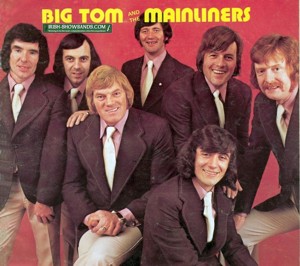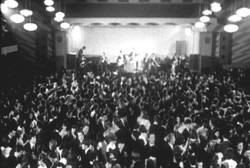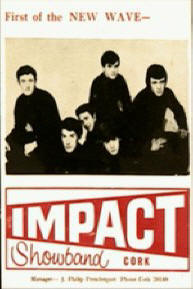|
 This website is dedicated to the Irish showbands
and much much more!
The term "Irish showband" generally refers to a particular type of
musical act popular in Ireland in the 1950's and 1960's.
Irish Showbands like the Clipper Carlton, the Dixies, the Royal, and hundreds more traveled the
length and breadth of Ireland playing to packed houses every night. We include
these showbands in our tribute, but we also feature much more. This website is dedicated to the Irish showbands
and much much more!
The term "Irish showband" generally refers to a particular type of
musical act popular in Ireland in the 1950's and 1960's.
Irish Showbands like the Clipper Carlton, the Dixies, the Royal, and hundreds more traveled the
length and breadth of Ireland playing to packed houses every night. We include
these showbands in our tribute, but we also feature much more.
Our website is dedicated to all the bands that played
Ireland's ballrooms, hotels, dancehalls,
marquees, and parochial halls between about 1955 and
1985.
With apologies to
those
 bands that never considered themselves part of the "showband scene," we feel this is the only unique term that aptly describes the industry which flourished in
Ireland for thirty-plus years. bands that never considered themselves part of the "showband scene," we feel this is the only unique term that aptly describes the industry which flourished in
Ireland for thirty-plus years.
Whether you were a fan of
The Royal or The Capitol, The Memories, or Chips,
Big Tom or Gloria, Mama's Boys or Bagatelle, we have something for you.
Our goal is to build the most comprehensive collection on this era
of Irish entertainment in the world, but we need your help. If you have photos, memories, information, updates, anything...we'd love to hear from you today!
click here for
our email or to contact us.
 The history of most
of today's popular music in Ireland traces its roots back to the country's "showband
era"
which swept through the country in the
late 1950's and 60's.
Prior to the
showbands, most "bands" in Ireland in the early 50's were similar to the "big bands" of the 1940's or orchestras.
They usually
had ten or twelve musicians who sat
behind music stands while a band leader, such as Mick Delahunty or Maurice Mulcahy, took center stage.
They played the Irish dance circuit which was mostly made up of small ballrooms
and the parochial halls that dotted the island. The history of most
of today's popular music in Ireland traces its roots back to the country's "showband
era"
which swept through the country in the
late 1950's and 60's.
Prior to the
showbands, most "bands" in Ireland in the early 50's were similar to the "big bands" of the 1940's or orchestras.
They usually
had ten or twelve musicians who sat
behind music stands while a band leader, such as Mick Delahunty or Maurice Mulcahy, took center stage.
They played the Irish dance circuit which was mostly made up of small ballrooms
and the parochial halls that dotted the island.
In the early 1950's, most of Ireland's
entertainment was provided by "orchestras," which were really just dance
bands with between 10-12 musicians. They usually featured piano, brass,
guitar, drums and sometimes two or three vocalists. Musicians sat on chairs
and read sheet music. Names like Brose Walsh, Mick Delahunty, and Maurice Mulcahy dominated the scene playing a mix of standard tunes and the popular
hits of the day. Adequate, danceable, but less than exciting to watch.
It wasn't long before someone got the idea (legend says it was the
Clipper Carlton Orchestra) to stand up and move to the music, and the "showband" was born!
Soon, most showbands featured 7 or 8 members, a full complement of brass, and a lead singer out front instead of a band leader.
Names like the Royal Showband featuring
Brendan Bowyer, the Miami featuring
Dickie Rock, and the Capitol Showband
featuring Butch Moore took the country by storm and at it's peak, it is
estimated that 700 to 800 showbands toured Ireland continuously (however, we
currently list over 1,000 on our showband page).
As the turbulent 60's gave way to the swinging seventies,
Irish showbands began changing, specializing in pop or country and the original showbands were forced to adapt to the changes
or die.
In the 70's and 80's, Ireland's entertainment landscape was divided into four basic types of music:
pop,
country and western, rock, and
folk.
Although bands from all genres coexisted and some even crossed over from one to another, the
Irish "dance" scene was divided mainly between the "pop" and "country and western" bands (sometimes called "country and
Irish"). Folk groups rarely played the dancehalls, and rock bands generally
played to smaller crowds in clubs, pubs and colleges. As the 70's progressed, though, several
rock bands made the transition to the "showband" circuit
and competed for gigs.
The emergence of discos in the mid 1970's gave promoters a new money making opportunity
as they could pay a single DJ to play records (as opposed to a six or seven piece band).
Hotels started converting ballrooms into "nightclubs" and there were fewer and fewer gigs available to the bands.
As competition
heated up for an ever dwindling number of venues, lesser known bands started to pack it in, and only bands with the strongest followings could still making a living "on the road."
 Sometime
in the mid 80's, the "showband era" was all but over.
Even though many of the top names of the era still perform today, the preeminence of the
Irish dancehall scene is now
just a memory. Most of the remaining bands play regularly in theatres, in cabaret, at weddings and corporate functions and in
England as there aren't enough dance venues left in Ireland.
Most of the ballrooms have been closed down, or converted into warehouses, furniture stores, garages, or community centers while others were simply demolished to make room for new development,
and sometimes as with rural ballrooms, back to an empty field! Sometime
in the mid 80's, the "showband era" was all but over.
Even though many of the top names of the era still perform today, the preeminence of the
Irish dancehall scene is now
just a memory. Most of the remaining bands play regularly in theatres, in cabaret, at weddings and corporate functions and in
England as there aren't enough dance venues left in Ireland.
Most of the ballrooms have been closed down, or converted into warehouses, furniture stores, garages, or community centers while others were simply demolished to make room for new development,
and sometimes as with rural ballrooms, back to an empty field!
Since the early 1990's there has been a
renewed interest in the showbands, but this has been focused almost exclusively on the big name showbands of the 60's.
There has been little written or said about the hundreds of bands that followed the showbands into the ballrooms, dancehalls, hotels,
and marquees of Ireland in the 70's and 80's. our goal is to ensure all
the bands are recognized for their contributions to Irish entertainment.
For many who were there, the era of the "Irish
Showbands" is looked upon with fondness. However, music critics haven't been as kind to this period in
Irish entertainment history. In the 2000 series, From A Whisper To A Scream,
Sir Bob Geldof refered to the showband years as a "musical desert," adding that,
"the showbands were crap." While this might be said of the musical "creativity"
and originality in the 50's and 60's, you would get a strong argument from many of the pop and rock bands that toured the country in the 70's and 80's.
They started writing and recording original material, some of it pretty good.
The quality of the musicianship in the showbands, while not
always consistent, is another topic that is hotly debated. Although reduced to playing "jive" music in the main, many "heads" were actually jazz lovers and enjoyed nothing more than a good jam session when not playing the ballrooms.
 Despite the "bad rap" given the
Irish showbands, they served an important function in allowing all musicians in
Ireland to learn their Despite the "bad rap" given the
Irish showbands, they served an important function in allowing all musicians in
Ireland to learn their
 craft.
The late Rory Gallagher, renown Irish blues and rock guitarist, started
out in a showband. Rory joined the Fontana showband from Cork, which soon changed it's name to the
Impact Showband (photo at left). Rory is down front on the right. Van Morrison also got his start in a showband,
as did Henry McCullough of Wings, like most
Irish musicians growing up in the 60's and 70's. In short, joining a showband was a way to learn the ropes and hone
one's musical chops. craft.
The late Rory Gallagher, renown Irish blues and rock guitarist, started
out in a showband. Rory joined the Fontana showband from Cork, which soon changed it's name to the
Impact Showband (photo at left). Rory is down front on the right. Van Morrison also got his start in a showband,
as did Henry McCullough of Wings, like most
Irish musicians growing up in the 60's and 70's. In short, joining a showband was a way to learn the ropes and hone
one's musical chops.
Even the biggest rock bands usually played the showband circuit.
Thin Lizzy played at Summerhill College and again in the Imperial Hotel in Sligo before
Whiskey In The Jar became an international hit. Bands like Horslips needed the dancehalls and marquees to make enough money to continue their
Celtic-rock experimentation.
One way or another, the Irish showbands gave many musicians a decent wage; provided patrons with much needed entertainment; and helped promoters make a lot of money!
 We dedicate this site to the thousands of musicians who strapped on a guitar, wielded a sax or trumpet, stood behind a keyboard, sat behind a kit of drums, or strutted their stuff out front!
Whether acknowledged or not, today's contemporary music industry in Ireland owes much to its showband heritage
that stretched from the mid 50's through the mid 80's. Please explore our site,
contribute your thoughts and enjoy! We dedicate this site to the thousands of musicians who strapped on a guitar, wielded a sax or trumpet, stood behind a keyboard, sat behind a kit of drums, or strutted their stuff out front!
Whether acknowledged or not, today's contemporary music industry in Ireland owes much to its showband heritage
that stretched from the mid 50's through the mid 80's. Please explore our site,
contribute your thoughts and enjoy!
|
